Inside Intel's Next Unit of Computing (DC3217BY)
by Anand Lal Shimpi on November 9, 2012 1:28 PM EST- Posted in
- Systems
- CPUs
- Intel
- Next Unit of Computing
Back at IDF Intel gave us a hands on demo of its Next Unit of Computing (NUC), a custom form factor motherboard that fits into an Intel-supplied 4" x 4" x 2" chassis. The first-generation NUC is built around a dual-core ULV Ivy Bridge CPU, the Core i3 3217U (17W TDP, 1.8GHz frequency, no turbo, HD 4000 graphics running at 350MHz - 1.05GHz).
Intel will be selling two versions of the NUC: the DC3217IYE and the DC3217BY:
| Intel NUC Kit Comparison | ||||
| DC3217IYE | DC3217BY | |||
| CPU | Intel Core i3-3217U | Intel Core i3-3217U | ||
| Chipset | Intel QS77 Express | Intel QS77 Express | ||
| RAM | 2 x DDR3 SO-DIMM slots | 2 x DDR3 SO-DIMM slots | ||
| HDMI Output | 2 | 1 | ||
| USB | 3 x USB 2.0 | 3 x USB 2.0 | ||
| Gigabit Ethernet | Y | N | ||
| Thunderbolt | N | Y | ||
| mini PCIe (half-height) | 1 | 1 | ||
| mini PCIe (full-height, mSATA support) | 1 | 1 | ||
| Chassis Color | Black | Black with Dark Red Top | ||
| Power Supply | External 19V DC | External 19V DC | ||
Intel sent along the DC3217BY which it expects to see on sale via Amazon and Newegg around early December for $300 - $320. For that price you basically get the motherboard (including CPU) and chassis. Memory, mini PCIe cards and even the power cord all come separately. The power cord you'll need to buy is a C6 type that plugs into the power adapter's C5 type connector. The 3-plug C6 connector is also known as a cloverleaf connector. My assumption here is to keep costs down Intel avoided including this part as they'd need to have a different cable depending on what part of the world the NUC was being sold into. The kit also comes with a VESA mounting bracket.
The main difference between the two models is the presence of GigE (-IYE suffix) vs Thunderbolt (-BY suffix), although the version without Thunderbolt comes with two HDMI ports instead of one. The Thunderbolt version ships with a dark red glossy top (pictured in the gallery below). You can drive a 2560 x 1440 panel off of the Thunderbolt port, although the usual Windows Thunderbolt compatibility requirements apply here.
Building the NUC is incredibly simple. There are four screws that hold the chassis together, removing them gives you access to the motherboard:
You don't actually need to go any further if you just want to get the NUC up and running. From here you can install up to two 8GB DDR3 SO-DIMMs. The bottom mini-PCIe slot accepts a half height card (perfect for WiFi) while the top slot can take a full height card or an mSATA drive. The antenna pigtails for WiFi are already routed to the appropriate spot inside the chassis. This model has an integrated Thunderbolt controller which you can see in the upper right of the machine.
Intel sent along its mSATA SSD 520 (180GB), which is a SandForce based mSATA drive from Intel using 25nm MLC NAND. SandForce controllers work very well in mSATA form factors since they don't require any external DRAM. There are only four IC packages on the mSATA 520: the controller itself plus 3 x 64GB 25nm MLC NAND devices. Intel's SSD Toolbox labels the drive as an SSD 525, however the part numbers above indicate 25nm NAND which would make this a 520.
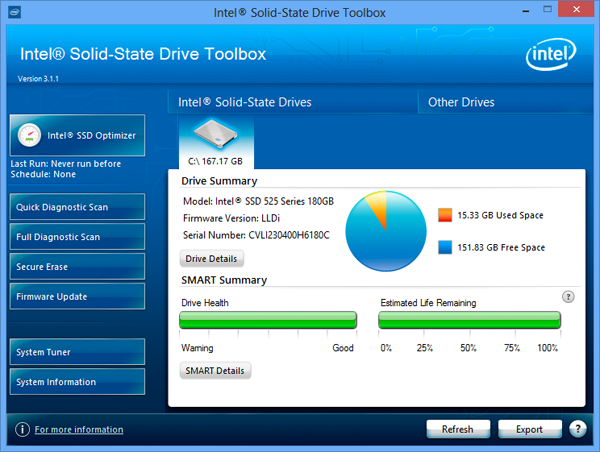
Going further, there are four screws that hold the motherboard in place, remove them and you can pull the board out completely:
On the underside of the motherboard you'll find the heatsink/fan covering the QS77 chipset and the Core i3 CPU:
Under heavy load the fan will kick in, but it's barely audible from more than 18" away from the chassis. The top of the plastic chassis does get quite warm (48.7C) while the CPU is running full tilt. The 65W power adapter will pull around 10W for the full system at idle and peak power consumption for the NUC tops out at 19.3W when running our x264 HD test.
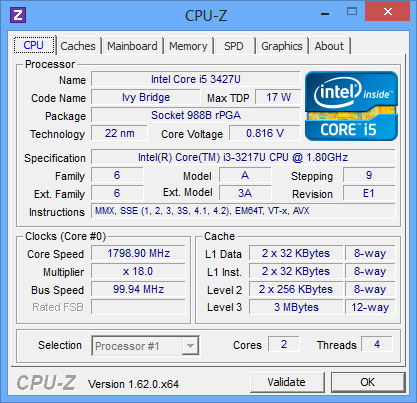
Performance is obviously going to be in line with other 17W mobile Ivy Bridge CPUs. We don't have a huge library of x264 HD 5.0.1 tests to compare to, but this should give you a bit of an idea of how the NUC would compare to a full blown 65W Core i3 based desktop PC:

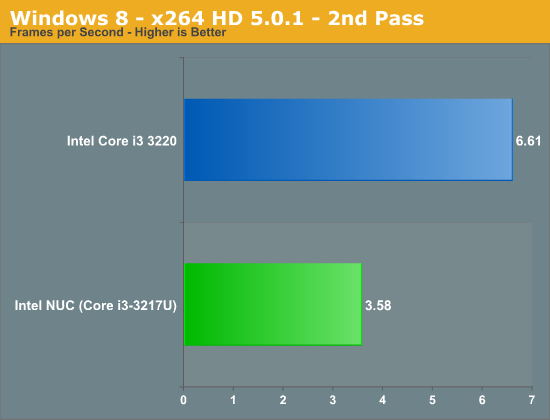
Compute bound tasks will obviously be slower, but lighter usage models will be just fine. Remember that this isn't an Atom based system, you'll actually get decent performance out of it. I'll be running some more benchmarks on the machine over the coming weeks, including a look at GPU performance.
The NUC is a nifty little concept and I'm glad Intel is bringing it to market. Obviously I don't see the NUC replacing everyone's desktop, but if you've got a specific application where form factor matters more than absolute performance (albeit one where you still need good performance) there may be a good fit here. What I'd love to see is for the NUC to be turned into a standard form factor, with a real ecosystem of multiple parts suppliers building components. Intel keeping it all in house, at least for the first revision, makes sense in order to establish a good baseline.









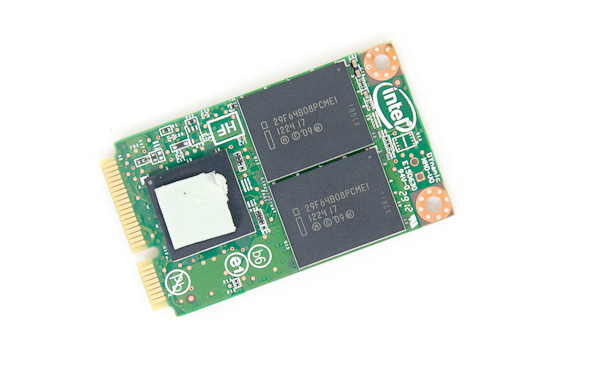
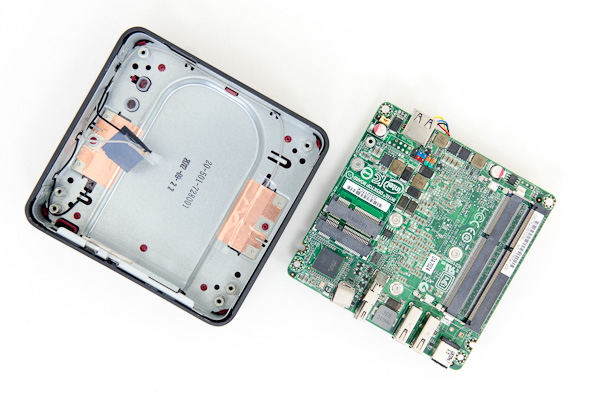
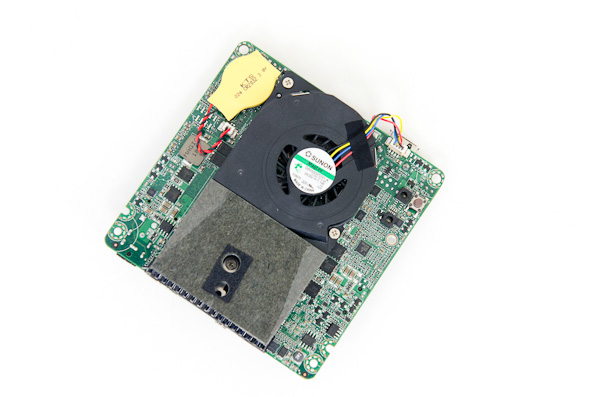








92 Comments
View All Comments
Wardrop - Sunday, November 11, 2012 - link
I don't mean to be an ass, but the saying is "all said and done". People I work with get catch phrases and idioms wrong every day. These are people I've worked with for 5 years, but I figure telling them after this amount of time will probably do more damage than it mends.drwhoglius - Friday, November 9, 2012 - link
Will you be able to use Apple's Thunderbolt to Gigabit Ethernet adapter with this?EnzoFX - Friday, November 9, 2012 - link
Is that the point of it not having Gigabit ethernet? Otherwise it seems strange.drwhoglius - Friday, November 9, 2012 - link
live in a hi-rise where every unit has the same Century Link ZyXel wireless router, speeds are hopelessly slow. have xbox+ps3 both wired up on ethernet, and a rats nest of cables behind my tv.DanNeely - Sunday, November 11, 2012 - link
Configure your ISPs crappy modem/router in bridge mode; connect a good router to it, and enjoy wifi that doesn't suck. With probably >95% of your neighbors too mundane to do the same picking a 5 ghz capable router will probably give completely unimpeded spectrum for whatever devices you have that support it.DanNeely - Friday, November 9, 2012 - link
As packed as the board is I'd guess there wasn't enough physical room for the ethernet controller and the thunderbolt controller because I don't see an empty space for a chip. We'd need to see an ethernet version of the board to be sure (look for a different chip where the TB one is on this model); and it looks like that gallery is all of the thunderbolt model.CaptainDoug - Friday, November 9, 2012 - link
If you're going to go this small, I say just get an AIO. I get that this is much more useful for those that keep their nice screen and just update the computer but they're making AIOs that are customizable.balsmanian - Friday, November 9, 2012 - link
Any idea how I could buy one of these to build a system?balsmanian - Friday, November 9, 2012 - link
Nevermind, just re-read the article and saw the early dec availability on Amazon/newegg.schizoide - Friday, November 9, 2012 - link
$320 - NUC$010 - power cord
$017 - 4GB DDR3 SO-DIMM RAM
$110 - cheapest mSATA SSD on newegg over 100GB, muskhkin atlas
-------------
$457
And of course unless you plan to run linux you need to pay for the OS too, $140 for windows 8 64bit OEM, so we're looking at $597.
Compare that to the cheapest mac mini at $599. Hmm, it costs two bucks more.
Note that it's not directly comparable. The cheapest mac mini does not have the "fusion drive", it's a 500GB slow laptop drive. You need to step up to the $799 model to get the fusion drive, although of course you can pop the $110 SSD into the mac mini too, that $200 also gets you a quadcore i7 and is actually quite a fast little computer. Speaking of speed, the base model mac mini has a dramatically faster CPU with a 2.5Ghz ivy bridge i5.
It's not as deep but much wider and longer. Unlike the NUC you get both gig-e and thunderbolt, and it has both an IR receiver built in for HTPC usage and wifi built-in too.
This is an interesting attempt from intel, but the price just isn't low enough for a home-built option to be a compelling alternative to buying something you know is going to be well-built and fully supported from apple.